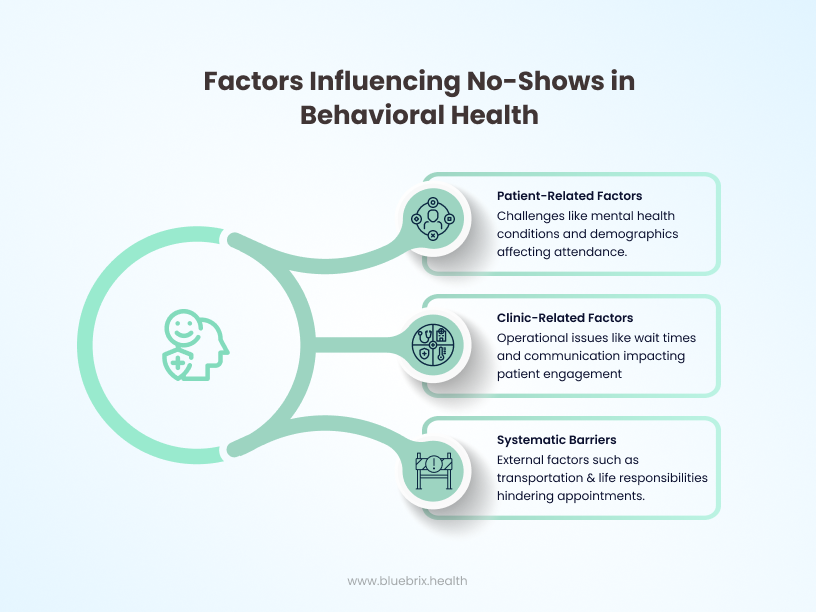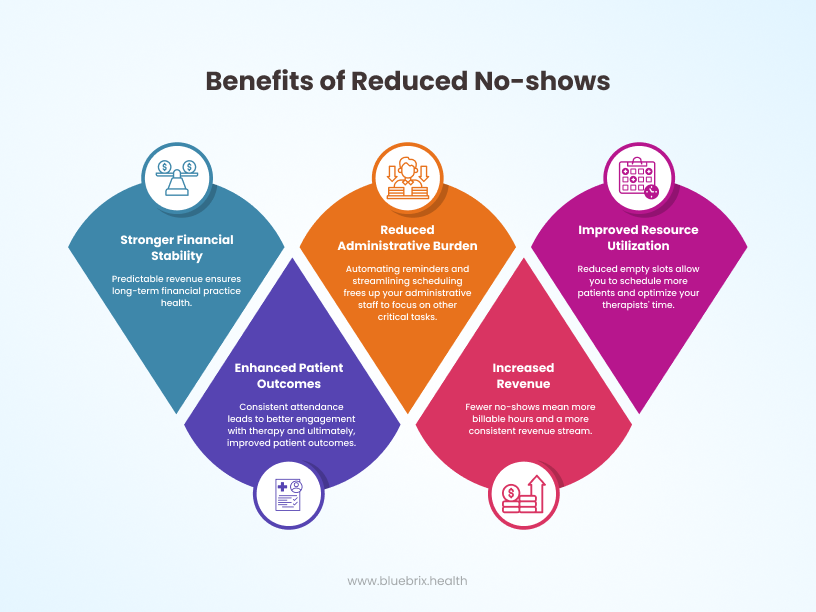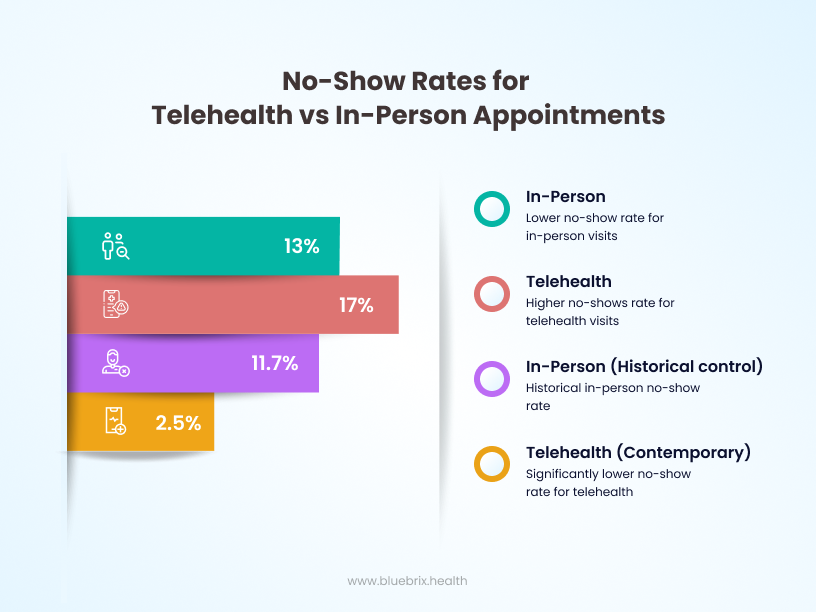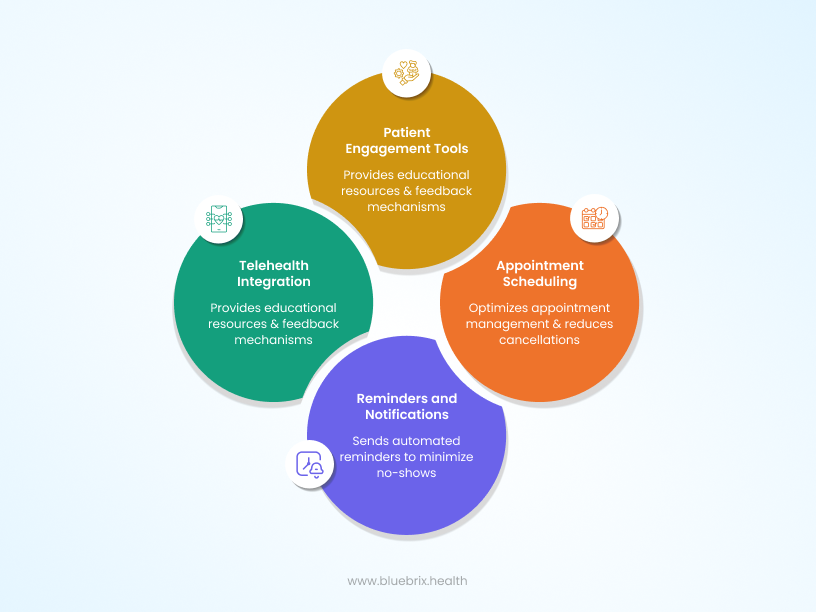Let’s talk about no-shows – a major issue faced by every behavioral health practice owner, from the solo virtual therapist to the multi-site outpatient clinics. That empty chair, the silent video call – it’s more than just a missed appointment. It’s a revenue drain, a disruption to patient care continuity, and frankly, a source of endless frustration.
Over our last decade and half years of close interactions with behavioral health clinicians, we’ve seen firsthand how these missed appointments can hemorrhage revenue and hinder the very mission we’re all striving for: to provide consistent, quality care. You’re not alone in this struggle. Small, medium, and enterprise outpatient clinics, community clinics as well as the burgeoning virtual practices, all grapple with the persistent challenge of no-shows.
But here’s the good news: the digital tools at our disposal have evolved significantly. We’re no longer relying on generic EHRs that treat behavioral health as an afterthought. Purpose-built Behavioral Health EHRs, like the platform we’ve meticulously crafted at blueBriX, offer a powerful arsenal to combat no-shows and plug that major revenue leak.
Think of your EHR as the central nervous system of your practice. If it’s not designed with the specific nuances of behavioral health in mind, it’s like trying to run a specialized marathon in generic sneakers. It might get you there eventually, but it won’t be efficient, comfortable, or optimized for peak performance.
So, how exactly can a purpose-built EHR be a game-changer in reducing no-shows? Let’s dive into the specifics, drawing on years of experience understanding your unique pain points and tailoring digital health solutions that truly align with your strategies and the diverse needs of your patient cohorts.
The Multifaceted Problem of No-Shows: Beyond Just Lost Revenue

Before we delve into the solutions, let’s acknowledge the complexity of the no-show issue in behavioral health. It’s rarely a simple case of forgetfulness. Often, it’s intertwined with the very conditions we treat:
- Executive Functioning Challenges: Many mental health conditions impact organization, planning, and memory, making appointment adherence difficult.
- Anxiety and Avoidance: The anticipation of therapy itself can trigger anxiety, leading to avoidance behaviors.
- Stigma and Shame: Lingering societal stigma can make individuals hesitant or ashamed to attend appointments.
- Practical Barriers: Transportation issues, childcare needs, and scheduling conflicts can create genuine obstacles.
- Lack of Perceived Value: If patients don’t fully understand the benefit of consistent therapy, they may be less likely to prioritize appointments.
- Communication Breakdown: Inadequate reminders or unclear communication about appointments can lead to missed sessions.
A generic EHR, designed for the broad strokes of medical care, often lacks the nuanced tools to address these specific behavioral health challenges. This is where a purpose-built platform shines.
The Tangible Benefits of Reducing No-shows

Reducing no-shows isn’t just about improving patient care; it has a direct and significant impact on your bottom line:
- Increased Revenue: Fewer no-shows mean more billable hours and a more consistent revenue stream.
- Improved Resource Utilization: Reduced empty slots allow you to schedule more patients and optimize your therapists’ time.
- Enhanced Patient Outcomes: Consistent attendance leads to better engagement with therapy and ultimately, improved patient outcomes.
- Reduced Administrative Burden: Automating reminders and streamlining scheduling frees up your administrative staff to focus on other critical tasks.
- Stronger Financial Stability: A predictable revenue stream contributes to the long-term financial health and sustainability of your practice.
Can Telehealth Solve the No-Show Problem—or Is It Just One Piece?

While there are many reasons patients miss their appointments—forgetfulness, anxiety, or simply being unprepared—the rise of telehealth has introduced a new layer of complexity. On the surface, it seems like the perfect fix for no-shows. Virtual visits eliminate travel time, reduce logistical hurdles, and make it easier for patients to access care from the comfort of their homes.
But here’s the catch: telehealth hasn’t reduced no-shows across the board—especially in behavioral health. A recent study of rural behavioral health clinics in Louisiana revealed that telehealth users were actually more likely to miss their appointments than in-person patients. Of the 9,715 appointments analyzed, 17% of telehealth patients were no-shows compared to 13% of in-person patients.
So, why does telehealth sometimes backfire? It turns out that relationship-building in behavioral health is harder through a screen. The absence of nonverbal cues—like facial expressions and body language—can weaken the therapeutic bond, making patients feel less connected. Tech issues—such as poor internet connections or unfamiliarity with virtual platforms—can also lead to missed sessions.
Interestingly, this isn’t the case for every specialty. In fact, telehealth has shown positive results for surgical patients. A study presented at the American College of Surgeons (ACS) conference in 2022 found that telehealth users were 79% less likely to miss appointments compared to in-person patients.
The takeaway? Telehealth is a double-edged sword—while it expands access, it also creates new barriers. For behavioral health providers, this means simply offering telehealth options isn’t enough. Bridging the digital gap, strengthening patient connections, and offering additional support are key to making telehealth a reliable tool for reducing no-shows.
blueBriX: Your Partner in Reducing No-shows
At blueBriX, we understand the unique challenges faced by behavioral health practices. Our purpose-built EHR platform is designed with these nuances in mind, offering a comprehensive suite of features to help you significantly reduce no-shows and optimize your revenue cycle.
Our highly customizable and configurable platform allows you to tailor workflows and communication strategies to the specific needs of your clinic and your diverse patient cohorts. End-to-end security and up-to-date compliance are baked into our DNA, ensuring you can focus on providing excellent care with peace of mind.
Furthermore, blueBriX is built to support value-based care by providing robust data analytics and reporting capabilities to track patient outcomes and demonstrate the effectiveness of your services. Our platform also facilitates whole-person care by enabling seamless integration with other healthcare providers and addressing social determinants of health.
blueBriX Purpose-Built Behavioral EHR: Your Strategic Weapon Against No-Shows
A well-designed Behavioral Health EHR isn’t just about storing records; it’s about actively engaging patients, streamlining communication, and anticipating potential barriers to attendance. Here’s how it can help you plug that revenue leak:

1. Intelligent Appointment Reminders: Beyond the Basic Ping
Generic EHRs often offer rudimentary reminders – a simple email or text the day before. But a purpose-built system understands that behavioral health patients often need more thoughtful and varied communication.
- Customizable Reminder Schedules: blueBriX allows you to configure reminder schedules based on patient preferences and appointment type. Some might respond best to a series of reminders – a week out, two days before, and the morning of. Others might prefer a single, well-timed message.
- Multi-Channel Communication: Reach patients where they are. Offer reminders via SMS, email, secure in-app messaging, and even automated phone calls. Different patients respond to different modalities.
- Personalized Messaging: Generic reminders can feel impersonal. A purpose-built system allows for personalized messages that reinforce the value of the appointment and address potential anxieties. For instance, a reminder for an initial intake appointment might include a reassuring message about what to expect.
- Two-Way Communication: Empower patients to easily confirm, reschedule, or cancel appointments directly through the reminder system. This reduces phone tag and provides you with real-time updates on your schedule.
- “Smart” Reminders: Leverage AI and NLP capabilities (which are core to the blueBriX platform) to analyze past no-show patterns and identify patients at higher risk. This allows you to implement more proactive interventions for these individuals.
2. Streamlined Scheduling and Rescheduling: Minimizing Barriers
A clunky or inflexible scheduling system can inadvertently contribute to no-shows.
- Easy Online Scheduling and Self-Service Portals: blueBriX offers patient portals that allow individuals to view their upcoming appointments, request rescheduling, and even book initial appointments online (where appropriate). This puts patients in control and reduces the friction associated with scheduling.
- Waitlist Management: Efficiently manage waitlists and automatically notify patients of earlier openings. Filling cancelled slots quickly minimizes lost revenue.
- Integration with Calendar Applications: Seamless syncing with patients’ personal calendars (Google Calendar, Outlook, etc.) reduces the chances of double-booking or forgetting appointments.
- Flexible Appointment Types: Support various appointment formats (in-person, telehealth, group therapy) within the scheduling system, catering to diverse patient needs and preferences.
3. Enhanced Patient Engagement and Education: Reinforcing Value
When patients understand the value of consistent therapy and feel connected to their care, they are more likely to prioritize appointments.
- Secure In-App Messaging: blueBriX’s secure messaging features allow for ongoing communication between sessions, fostering a stronger therapeutic alliance and addressing any concerns that might lead to a no-show.
- Educational Resources: Share relevant articles, videos, and self-help materials through the patient portal, reinforcing the importance of their treatment plan.
- Progress Tracking and Visualization: Allow patients to track their progress towards their goals within the EHR. Seeing tangible improvements can increase motivation and adherence.
- Telehealth Integration: For virtual clinics, a purpose-built behavioral health EHR with seamless telehealth integration reduces the technical barriers to attending appointments. One-click access to secure video sessions minimizes technical difficulties that could lead to no-shows.
4. Addressing Social Determinants of Health (SDOH): A Holistic Approach
We know that factors beyond mental health symptoms can significantly impact appointment attendance. A purpose-built EHR can help you identify and address these barriers:
- SDOH Screening and Documentation: blueBriX allows you to systematically screen for and document SDOH factors like transportation issues, housing instability, and food insecurity.
- Referral Management: Seamlessly connect patients with resources to address identified SDOH needs, potentially removing barriers to attendance.
- Care Coordination: Facilitate communication and collaboration with other providers involved in the patient’s care, ensuring a holistic approach that supports appointment adherence.
5. Leveraging AI and NLP for Predictive Insights:
This is where a modern, platform-based behavioral health EHR like blueBriX truly shines.
- No-Show Risk Prediction: AI algorithms can analyze historical data (appointment history, demographics, SDOH factors, engagement levels) to identify patients at higher risk of not showing up. This allows for targeted interventions, such as more frequent check-ins or personalized reminders.
- Natural Language Processing (NLP) for Sentiment Analysis: Analyze patient communications (secure messages, progress notes) to identify potential concerns or anxieties that might be precursors to a no-show. This enables proactive outreach and support.
6. Using Patient Feedback to Improve Retention
Sometimes, no-shows happen because patients feel disconnected from their care. That’s why we have included feedback tools that allow practices to collect insights directly from patients.
Post-appointment satisfaction surveys can uncover barriers patients face, whether it’s a scheduling issue, dissatisfaction with the care process, or another challenge. By acting on this feedback, practices can make meaningful improvements that increase patient engagement and retention.




